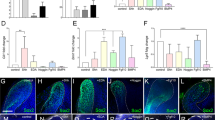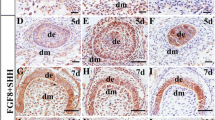Abstract
Dental enamel formation, known as “amelogenesis,” is initiated by cytodifferentiation of the ectodermally derived dental epithelium. Enamel cannot regenerate itself because once it is completely formed, ameloblasts are lost as the tooth erupts. Rodent teeth have been useful for studying the mechanisms of amelogenesis because ameloblast cell lines can be derived from the ever-growing incisors. However, higher mammals such as humans have no growing teeth, and cell lines derived from larger animals that are more similar to humans are required for higher fidelity studies. Here, we isolated embryonic enamel epithelium-derived epithelial cells from fetal swine. The explant culture of the developing deciduous molars that had been removed from the dental papilla-derived mesenchymal tissue and cells inside the tooth buds provided the epithelial cell population for the primary culture. To isolate the cell population, we performed a unique cell isolation technique called cell fishing. The isolated cells showed clear embryonic-stage ameloblast characteristics with appropriate gene/protein expressions of enamel matrix and proteinases, abundant glycogen pools, and secretory granular materials. They could be continuously subcultured several times and are presently being maintained. This cell population will facilitate the establishment of a stable cell line and allow us to characterize the definitive phenotype and functional behavior of porcine ameloblasts, which, in turn, promises to yield useful and practical findings that are more relevant than those provided by rodent studies. Finally, analysis of in vitro enamel formation will be important for engineering “bio-enamel” as a new dental therapy to restore enamel defects.





Similar content being viewed by others
References
Abiko Y, Nishimura M, Arai J, Kuraguchi J, Saitoh M, Kaku T (1996) Apoptosis in the reduced enamel epithelium just after tooth emergence in rats: in situ labeling of nuclear DNA fragmentation and electron microscopic studies. Med Electron Microsc 29:84–89
Bartlett JD (2013) Dental enamel development: proteinases and their enamel matrix substrates. ISRN Dent 2013:684607
Chen LS, Couwenhoven RI, Hsu D, Luo W, Snead ML (1992) Maintenance of amelogenin gene expression by transformed epithelial cells of mouse enamel organ. Arch Oral Biol 37:771–778
Chu CR, Szczodry M, Bruno S (2010) Animal models for cartilage regeneration and repair. Tissue Eng Part B Rev 16:105–115
DenBesten PK, Gao C, Li W, Mathews CH, Gruenert DC (1999) Development and characterization of an SV40 immortalized porcine ameloblast-like cell line. Eur J Oral Sci 107:276–281
DenBesten PK, Machule D, Zhang Y, Yan Q, Li W (2005) Characterization of human primary enamel organ epithelial cells in vitro. Arch Oral Biol 50:689–694
DenBesten PK, Mathews CH, Gao C, Li W (1998) Primary culture and characterization of enamel organ epithelial cells. Connect Tissue Res 38:3–8, discussion 35–41
Ding G, Liu Y, Wang W, Wei F, Liu D, Fan Z, An Y, Zhang C, Wang S (2010) Allogeneic periodontal ligament stem cell therapy for periodontitis in swine. Stem Cells 28:1829–1838
Ide Y, Nakahara T, Nasu M, Matsunaga S, Iwanaga T, Tominaga N, Tamaki Y (2013) Postnatal mandibular cheek tooth development in the miniature pig based on two-dimensional and three-dimensional X-ray analyses. Anat Rec 296:1247–1254
Jernvall J, Thesleff I (2000) Reiterative signaling and patterning during mammalian tooth morphogenesis. Mech Dev 92:19–29
Kawano S, Morotomi T, Toyono T, Nakamura N, Uchida T, Ohishi M, Toyoshima K, Harada H (2002) Establishment of dental epithelial cell line (HAT-7) and the cell differentiation dependent on Notch signaling pathway. Connect Tissue Res 43:409–412
Li W, Machule D, Gao C, DenBesten PK (2006) Growth of ameloblast-lineage cells in a three-dimensional Matrigel environment. Eur J Oral Sci 114(Suppl 1):159–163, discussion 164–155, 380–151
Limeback H (1987) Enamel protein and collagen production by cells subcultured from porcine tooth bud explants. Biochem Cell Biol 65:698–709
McCall FC, Telukuntla KS, Karantalis V, Suncion VY, Heldman AW, Mushtaq M, Williams AR, Hare JM (2012) Myocardial infarction and intramyocardial injection models in swine. Nat Protoc 7:1479–1496
Meurens F, Summerfield A, Nauwynck H, Saif L, Gerdts V (2012) The pig: a model for human infectious diseases. Trends Microbiol 20:50–57
Nakata A, Kameda T, Nagai H, Ikegami K, Duan Y, Terada K, Sugiyama T (2003) Establishment and characterization of a spontaneously immortalized mouse ameloblast-lineage cell line. Biochem Biophys Res Commun 308:834–839
Nasu M, Nakahara T, Tominaga N, Tamaki Y, Ide Y, Tachibana T, Ishikawa H (2013) Isolation and characterization of vascular endothelial cells derived from fetal tooth buds of miniature swine. In Vitro Cell Dev Biol Anim 49:189–195
Ohshima H, Wartiovaara J, Thesleff I (1999) Developmental regulation and ultrastructure of glycogen deposits during murine tooth morphogenesis. Cell Tissue Res 297:271–281
Seok J, Warren HS, Cuenca AG, Mindrinos MN, Baker HV, Xu W, Richards DR, McDonald-Smith GP, Gao H, Hennessy L, Finnerty CC, Lopez CM, Honari S, Moore EE, Minei JP, Cuschieri J, Bankey PE, Johnson JL, Sperry J, Nathens AB, Billiar TR, West MA, Jeschke MG, Klein MB, Gamelli RL, Gibran NS, Brownstein BH, Miller-Graziano C, Calvano SE, Mason PH, Cobb JP, Rahme LG, Lowry SF, Maier RV, Moldawer LL, Herndon DN, Davis RW, Xiao W, Tompkins RG, Inflammation, Host Response to Injury LSCRP (2013) Genomic responses in mouse models poorly mimic human inflammatory diseases. Proc Natl Acad Sci U S A 110:3507–3512
Shinmura Y, Tsuchiya S, Hata K, Honda MJ (2008) Quiescent epithelial cell rests of Malassez can differentiate into ameloblast-like cells. J Cell Physiol 217:728–738
Swindle MM, Makin A, Herron AJ, Clubb FJ Jr, Frazier KS (2012) Swine as models in biomedical research and toxicology testing. Vet Pathol 49:344–356
Ten Cate A (1962) The distribution of glycogen in the human developing tooth. Arch Oral Biol 7:1–6
Tominaga N, Nakahara T, Nasu M, Satoh T (2013) Isolation and characterization of epithelial and myogenic cells by “fishing” for the morphologically distinct cell types in rat primary periodontal ligament cultures. Differentiation 85:91–100
Wang S, Liu Y, Fang D, Shi S (2007) The miniature pig: a useful large animal model for dental and orofacial research. Oral Dis 13:530–537
Wei F, Song T, Ding G, Xu J, Liu Y, Liu D, Fan Z, Zhang C, Shi S, Wang S (2013) Functional tooth restoration by allogeneic mesenchymal stem cell-based bio-root regeneration in swine. Stem Cells Dev 22:1752–1762
Whyte JJ, Prather RS (2011) Genetic modifications of pigs for medicine and agriculture. Mol Reprod Dev 78:879–891
Yan Q, Zhang Y, Li W, DenBesten PK (2006) Differentiation of human ameloblast-lineage cells in vitro. Eur J Oral Sci 114(Suppl 1):154–158, discussion 164–155, 380–151
Zeichner-David M, Diekwisch T, Fincham A, Lau E, MacDougall M, Moradian-Oldak J, Simmer J, Snead M, Slavkin HC (1995) Control of ameloblast differentiation. Int J Dev Biol 39:69–92
Acknowledgments
The authors thank the members of the Department of Anatomy at The Jikei University School of Medicine, Tokyo, Japan, for the valuable discussions and comments. This work was supported by a Grant-in-Aid for Young Scientists (A) (No. 24689073 to T.N.) and a Grant-in-Aid for Scientific Research (B) (No. 15H05046 to T.N., T.T., Y.I., and H.I.) from the Japan Society for the Promotion of Science (JSPS KAKENHI Grant Numbers 24689073 and 15H05046).
Author information
Authors and Affiliations
Corresponding author
Additional information
Editor: Tetsuji Okamoto
Rights and permissions
About this article
Cite this article
Nakahara, T., Tominaga, N., Toyomura, J. et al. Isolation and characterization of embryonic ameloblast lineage cells derived from tooth buds of fetal miniature swine. In Vitro Cell.Dev.Biol.-Animal 52, 445–453 (2016). https://doi.org/10.1007/s11626-015-9987-7
Received:
Accepted:
Published:
Issue Date:
DOI: https://doi.org/10.1007/s11626-015-9987-7




